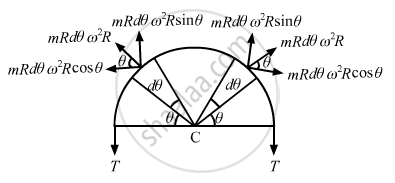Advertisements
Advertisements
प्रश्न
A circular loop of string rotates about its axis on a frictionless horizontal place at a uniform rate so that the tangential speed of any particle of the string is ν. If a small transverse disturbance is produced at a point of the loop, with what speed (relative to the string) will this disturbance travel on the string?
उत्तर
Let,
V = Linear velocity of the string
m = Mass per unit length of the the string.
R = Radius of the loop
ω = Angular velocity
Consider one half of the string, as shown in the figure.
The half loop experiences centrifugal force at every point (away from the centre) balanced by tension 2T.
Consider an element of angular part dθ at angle θ.
So,
Length of the element
\[= Rd\theta, mass = mRd\theta\]
Centrifugal force experienced by the element
\[= \left( mRd\theta \right) \omega^2 R\]
Resolving the centrifugal force into rectangular components,
Since the horizontal components cancel each other, the net force on the two symmetric elements is given as
\[dF = 2m R^2 d\theta \omega^2 sin\theta\]
\[Total force, F = \int_0^\pi/2 2m R^2 \omega^2 \sin\theta d\theta\]
\[= 2m R^2 \omega^2 \left[ - \cos \theta \right]\]
\[ = 2m R^2 \omega^2 \]
\[And, \]
\[2T = 2m R^2 \omega^2 \]
\[ \Rightarrow T = m R^2 \omega^2\]
Velocity of the transverse vibration is given as
\[V' = \sqrt{\left( \frac{T}{m} \right)}\]
\[V' = \sqrt{\left( \frac{m R^2 \omega^2}{m} \right)} = \omega R\]
Linear velocity of the string, V = \[\omega R\]
∴ Speed of the disturbance, V' = V
APPEARS IN
संबंधित प्रश्न
Explain why (or how) The shape of a pulse gets distorted during propagation in a dispersive medium.
Explain the reflection of transverse and longitudinal waves from a denser medium and a rared medium.
A mechanical wave propagates in a medium along the X-axis. The particles of the medium
(a) must move on the X-axis
(b) must move on the Y-axis
(c) may move on the X-axis
(d) may move on the Y-axis.
A transverse wave travels along the Z-axis. The particles of the medium must move
Longitudinal waves cannot
A wave going in a solid
(a) must be longitudinal
(b) may be longitudinal
(c) must be transverse
(d) may be transverse.
A wave moving in a gas
Mark out the correct options.
Two wires of different densities but same area of cross section are soldered together at one end and are stretched to a tension T. The velocity of a transverse wave in the first wire is double of that in the second wire. Find the ratio of the density of the first wire to that of the second wire.
Two blocks each having a mass of 3⋅2 kg are connected by a wire CD and the system is suspended from the ceiling by another wire AB (See following figure). The linear mass density of the wire AB is 10 g m−1 and that of CD is 8 g m−1. Find the speed of a transverse wave pulse produced in AB and CD.

A heavy but uniform rope of length L is suspended from a ceiling. (a) Write the velocity of a transverse wave travelling on the string as a function of the distance from the lower end. (b) If the rope is given a sudden sideways jerk at the bottom, how long will it take for the pulse to reach the ceiling? (c) A particle is dropped from the ceiling at the instant the bottom end is given the jerk. Where will the particle meet the pulse?
A tuning fork of frequency 440 Hz is attached to a long string of linear mass density 0⋅01 kg m−1 kept under a tension of 49 N. The fork produces transverse waves of amplitude 0⋅50 mm on the string. (a) Find the wave speed and the wavelength of the waves. (b) Find the maximum speed and acceleration of a particle of the string. (c) At what average rate is the tuning fork transmitting energy to the string?
A wire, fixed at both ends is seen to vibrate at a resonant frequency of 240 Hz and also at 320 Hz. (a) What could be the maximum value of the fundamental frequency? (b) If transverse waves can travel on this string at a speed of 40 m s−1, what is its length?
Three resonant frequencies of a string are 90, 150 and 210 Hz. (a) Find the highest possible fundamental frequency of vibration of this string. (b) Which harmonics of the fundamental are the given frequencies? (c) Which overtones are these frequencies? (d) If the length of the string is 80 cm, what would be the speed of a transverse wave on this string?
The equation of a standing wave, produced on a string fixed at both ends, is
\[y = \left( 0 \cdot 4 cm \right) \sin \left[ \left( 0 \cdot 314 {cm}^{- 1} \right) x \right] \cos \left[ \left( 600\pi s^{- 1} \right) t \right]\]
What could be the smallest length of the string?
The phenomenon of beats can take place
Given below are some functions of x and t to represent the displacement (transverse or longitudinal) of an elastic wave. State which of these represent (i) a traveling wave, (ii) a stationary wave or (iii) none at all:
y = 2 cos (3x) sin (10t)
Given below are some functions of x and t to represent the displacement (transverse or longitudinal) of an elastic wave. State which of these represent (i) a traveling wave, (ii) a stationary wave or (iii) none at all:
y = 3 sin (5x – 0.5t) + 4 cos (5x – 0.5t)
